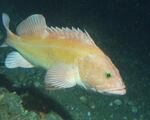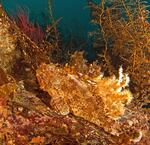
Groundfish trawlers will soon be allowed to catch more fish as depleted populations recover from overfishing.
Michael Bendixen / OPB
Federal fishery managers are increasing the catch limits for several West Coast species that were overfished and severely restricted for years.
Surveys show depleted populations of yellow eye and bocaccio rockfish, cow cod and ocean perch — all classified as groundfish — are rebounding decades ahead of schedule.
As a result, the National Marine Fisheries Service plans to double the catch limits for these fish starting Jan. 1.
It’s a major milestone in the recovery of a fishery that endured major cutbacks and tumultuous changes since it was declared a federal disaster in 2000.
For some species, the catch limits are more than doubling. The limit for ocean perch is spiking 1,444 percent. The changes could increase fishing income in Oregon, Washington and California by $60 million and generate hundreds of jobs, the agency reports.
John Holloway, a fisherman and chairman of a federal groundfish advisory panel, said the resurgence of fish is the result of new science, major fishery management overhauls and a change in culture both in the fishing industry and among regulators.
“It cost the fishing industry a lot," he said. "The entire culture had to change. I give kudos to the fishing industry because they’ve been through some tough times."
Recovering From A Disaster
To rebuild collapsed fish populations, managers closed huge sections of the ocean to fishing and severely reduced catch limits. Restrictions on overfished stocks hobbled fishermen for years because it prevented them from catching more abundant fish species.

Yelloweye rockfish have been severely restricted because of overfishing, but they're recovering much faster than expected.
Courtesy of NOAA
Groundfish trawlers catch more than a hundred different species, including lingcod, Dover sole and all kinds of rockfish. To alleviate fishing pressure, the fleet went through a buyback process that withdrew hundreds of fishing permits and took nearly a hundred boats off the water for good.
Then, in 2011, the fishery switched to a whole new system of management called catch shares, where each boat gets its own share of the total catch to fish, sell or trade.
New Science
Meanwhile, scientists were learning more about how how quickly some rockfish species are able to reproduce — even when their populations are low, according to Jason Cope, fishery biologist for the Northwest Fisheries Science Center.
"We thought it might take a century or so for them to rebuild themselves, but it’s now taking maybe about a decade," he said.
In the past several years, all but two overfished species have been completely rebuilt — much faster than anyone expected. So, fishermen now have fewer restricted fish to avoid and higher catch limits on the species that are still rebuilding.
"So, all of these things are kind of adding up," Cope said. "We have a different view of the biology, there have been a lot of drastic cuts, and the industry has been wonderful in allowing these stocks to take on less fishing pressure. We’re seeing some really positive results now and it’s quite wonderful to see."

Scorpionfish are one of dozens of species that live on the bottom of the Pacific Ocean and get caught in groundfish trawl nets.
Courtesy of NOAA
Holloway said the new, more generous catch limits still have built-in buffers to protect the stocks.
“Everyone agreed not to go too far in case there was something wrong with the stock assessment,” he said.
Cope said scientists still have a lot to learn about groundfish species, so they're still moving cautiously as they expand the fishery.
"It’s an ongoing learning process with a lot of uncertainty," he said. "But a lot of these stocks have increased to the point where we feel a lot better than we did 15-plus years ago."
